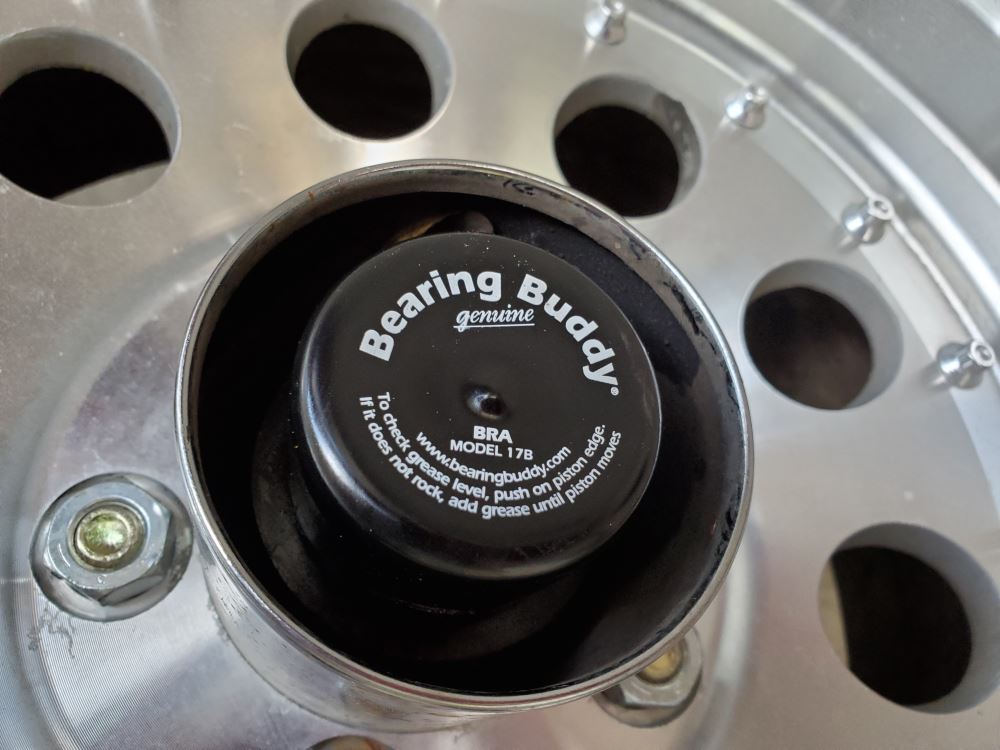

No water in bearings for years now, and pulling the breaks and hub off yearly keeps everything lubed up and functional. I think I went a step too far in getting preload spot on, sometimes I get carried away. I even got the lads at work to machine me a castle nut washer that is 150% and one 175% thickness of the standard washer so I can be very picky with my preload. I keep the bearing seals spot on once a year and use normal grease amounts for wheel bearings. Increase the depth of the dent if the effort to get the buddy off is not enough. There is a place for everything, but Buddy Bearings on a TT no.I have them on my boat trlr, and for 20 yrs. How much of a dent should you make? Well do a little and see how hard it is to get the buddy off and on. I used to do 3 center tap hit, only slight ones, at 120deg apart. If you are uncertain as to what Bearing Buddies will fit.

So it is harder to have the buddy fall out. Hanna Trailer Supply carries a wide inventory of Bearing Buddy products to fit your wheel hubs. The deformity rise reduces the overall diameter of where you are putting the bearing buddy, so the buddy is harder to hammer in, so the interference fit between the buddy and hub is tighter. The deformity occurs as a rise on the inner side of the hub (where the buddy slides in) and outer side of hub. When you center punch the edge the hub material deforms slightly (to make a dent you need to make a rise somewhere else). This hub edge needs a light hit with a center punch and hammer. That will not pop the seal and will not force out any water. Proper use of a bearing buddy is to pump grease in until the disk just begins to move outward. Bearing buddies are not intended to completely fill the hub with grease and besides, that's not even necessary. Where you put the buddy onto the hub and tap buddy in with a hammer, there is a 5mm edge on the hub that faces out. A bearing buddy has a spring loaded disk that has the grease zerk installed in it.
#BEARING BUDDY FULL#
As I said above, this couldn't be the case as they were only partially full the second time and even the steel caps disappear. Ive done a bit of googling and most people suggest it could be result of the bearing buddies being too full of grease. Im bringing it back to the tyre shop tomorrow but was just after a bit of info/ ammo if anyone has had the same experience? Ive had a look at the hubs themselves and their doesn't seem to be an excess play in the wheels which could cause them to come loose.Ĭould possibly be the wrong type of bearings (holden/ ford etc) were used? Has anyone experienced this before and if so, what was the problem, cause its got me buggered. They caps were on tight and a good fit, so much so that I couldn't just take them off by hand after each launch/ retrieve.

With not much other options, I bought 6 more caps and just repeated this process each day. By the time I had pulled the boat out at the end of the day and dragged it back to the mates place I was staying at, the steel caps were also gone. WTF? I decided to carry on with them bare and bought a few of the plain steel caps in exxy, and put them on at the boat ramp before putting the boat in. I stopped through coral bay for lunch, and they were both gone again. So I put them on myself and only partially filled them (the buddies) with grease and headed off. By the time I got there, I had also lost the 2nd one. I though they may not have been knocked in properly or perhaps overfilled, causing too much pressure etc and forcing them to pop off, so I cut my losses and stopped through autopro and got another set to put on myself. They looked the goods, but by the time I got to the local servo to fuel up, one of the bearing buddies had fallen off. An automatic pressure relief feature precents over-filling the hub, which would damage seals.įits hubs with an inner diameter of 1.98" 50.I had my trailer bearings and buddies replaced a couple of weeks ago in preparation for a trip from home (Carnarvon) to Exmouth. With the pressure inside the hub slightly higher than the pressure outside the hub, water and grit cannot be drawn inside. Once the hub is full, the spring-loaded piston in the Bearing Buddy® exerts a slight pressure to the grease inside the hub. Most air that is trapped inside the hub will be expelled by the Bearing Buddy® pressure relief feature. Perfectly good bearings can be ruined in less than one season.īearing Buddy® corrects this problem by filling the entire hub with grease. The contamination causes corrosion and rapid wear.
#BEARING BUDDY HOW TO#
The vacuum pulls water and road grit inside the hub, contaminating the grease. In this video we will show you how to determine the correct Bearing size for your trailer and what to do before installation. Warm hubs backed into cool water during launching are suddenly cooled which contracts any air inside the hub creating a vacuum. Boat trailer hubs get warm while traveling to the ramp.


 0 kommentar(er)
0 kommentar(er)
